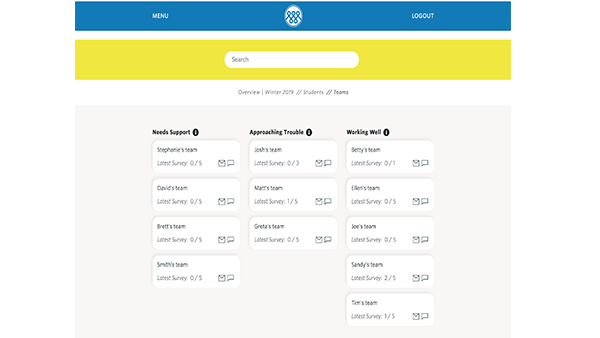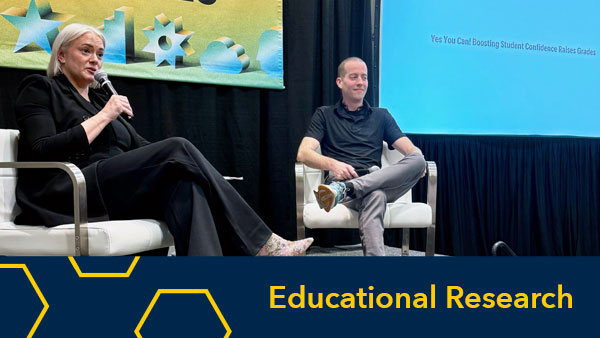Holly Derry, Associate Director of Behavioral Science
Group projects.
Many people we talk to about group projects say things like “One person totally took over” or “I ended up doing all the work.” We also hear “As the only woman, I got stuck taking notes.” We believe it doesn’t have to be that way, so we set out to make group work better.
Academic Innovation teamed up with Robin Fowler, Laura Alford, and Stephanie Sheffield from the College of Engineering to create Tandem, a tailored software tool that supports students working on group projects.
“A bad teaming experience can sour students on collaboration, and can convince them that their voices aren’t being heard or valued. With Tandem, we get to help students recognize the value of their own voices; that these voices are likely to be those of underrepresented populations makes a support system like Tandem even more necessary.”
~ Stephanie Sheffield, Faculty Innovator
And now, as the title promises, here are the 3 things to know about Tandem:
1. Tandem uses data to connect students and instructors.
It’s human nature to want feedback on our performance and progress. The Tandem team believes that if students and instructors receive timely information about how things are going, teams may resolve issues before they spiral out of control.
Tandem charts weekly team checks for students on five dimensions: how the team is doing overall, logistics, idea equity, workload equity, and confidence they’re going to do well.

Teams can use the information to check in with each other and make course corrections. They can see, at a meta level, how their own personalities mesh with others’ and learn new ways to work better with people who are different from them.
“Tandem scaffolds students as they reflect on what is working well (or not) for their teams. It provides them with evidence-based strategies to try, tailored to the particular struggles of their team. We hope it will improve team experiences in the moment but also improve students’ ability to abstract from this team experience and transfer this knowledge about themselves and about interacting with others to new teaming situations.”
~ Robin Fowler, Faculty Innovator
In addition, instructors can see how teams are doing and which dimensions need improvement. The Instructor Dashboard also gives additional context to instructors so they also know why teams might need support.
“One enlightening moment I had while working on Tandem was hearing from instructors how challenging it is to not assign stereotypical labels (e.g. slackers, overachievers, etc.) to students who are having issues with their teamwork. It means that Tandem needs to be just as effective at engendering empathy and equity in instructors as it is in students.”
~ Molly Maher, Behavioral Scientist

“Tandem takes in hundreds of thousands of data points over time and converts these into a small amount of useful output. The Instructor Dashboard is ‘mission control’ for instructors and clearly tells them which teams and individuals need additional support (as determined by our algorithm), as well as providing an overall view of everything happening in the current class at a glance.”
~ Ollie Saunders, Software Developer
2. Tandem is tailored for each team and individual.
Tandem’s beginning of term survey asks students about their personalities and work preferences, including their likelihood to speak up in a group or work close to a deadline. The tool then uses this information, along with weekly team checks, to tailor the students’ lessons and activities.
“We are lucky to work with an incredibly diverse student population, and we know that everyone learns and works differently. Tandem’s beginning of term survey helps both faculty and students understand what their strengths are and what areas we want to work on over the coming semester. I love that Tandem gives students feedback and strategies that are specific to them and their current team situation — just like I would do if I was meeting with each student every day.”
~ Laura Alford, Faculty Innovator
A team may have trouble sharing ideas equitably, and so they’re assigned a lesson on communication, which points out when a student’s survey answers indicate they’re more likely to listen rather than speak. The lesson talks about why that might be a challenge for them or the team, and in the activity, the students see different thought-provoking reflection questions personalized to their communication styles. By raising awareness early on, individuals have more insight about their differences and gain a shared language to have a productive conversation about these differences. When conflict does arise, team members may have healthier attributions for the conflict: “Maybe my ideas aren’t in the final design because I didn’t speak up much, not because the team doesn’t care.” And over time, teams may also learn to adapt to each other’s styles: “Tom’s quiet again. How can our team make sure he has the space to speak up?”
3. Tandem is the product of many disciplines.
- Behavioral scientists work with instructors to figure out which positive and negative team and individual behaviors to target. They also work closely to develop the surveys, lessons, and activities.
- Learning experience designers help the behavioral science team align activities with learning objectives of the lessons.
- User experience designers ensure Tandem’s user interface is easy to use so students can see which surveys and lessons are due, as well as make sense of their team’s ongoing data.
- Software developers make the tool operate smoothly so that students get the right message at the right time based on the correct data.
- User research specialists interview instructors and students so that Tandem focuses on topics and feature sets that bring value to users.
- Data scientists meet with the Tandem team each week to make sure the algorithms that assign lessons and triage teams are adjusted properly.
“The Manage Members page was one of the most challenging pages within the site to style and code. It allows faculty to build teams by dragging and dropping members onto or between teams. The drag and drop functionality was new for me and was fun to get familiar with, and I worked very closely with one of our developers, Ke Yu.”
~ Kristen Miller, UX Designer
What’s next for Tandem?
This term, we’re piloting Tandem in Engineering 100 with a group of 60 engineering students. In the next year, we have plans to expand into courses that will stretch Tandem’s capabilities even further. We’ll think more about group formation, changing groups multiple times in a term, and adding a wider range of lessons and reflection activities. In the future, the tool aims to move beyond programmed algorithms and use machine learning to form teams, predict possible issues, and address teaming issues.


